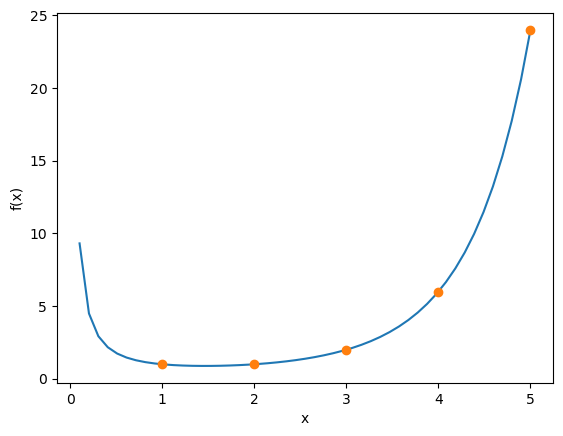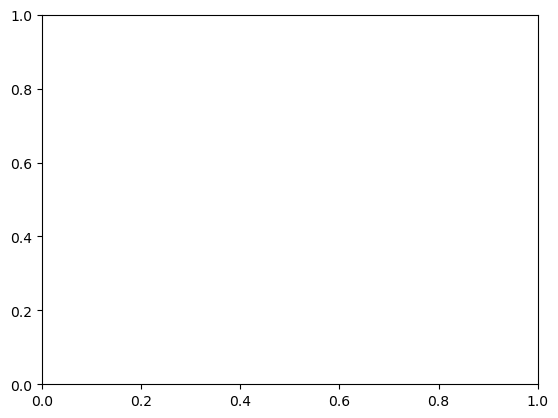9. Stochastic Methods: Exercise#
Name:
import numpy as np
import matplotlib.pyplot as plt
%matplotlib inline
1. Integration#
When an explicit function like \(x_n = g(x_1,...,x_{n-1})\) is not available, you can use a binary function that takes 1 within and 0 outside of a region to measure its volume.
Measure the volume of an n-dimensional sphere using a binary function
Measure the area or volume of a shape of your interest by sampling method.
2. Rejection Sampling#
Let us generate samples from Gamma distribution
with the shape parameter \(k>0\) and the scaling parameter \(\theta\) using the gamma function \(\Gamma(k)\) available in scipy.special.
from scipy.special import gamma
from scipy.special import factorial
Here is how the gamma function looks like, together with factorial at integer values.
kmax = 5
x = np.linspace(0, kmax, 50)
plt.plot(x, gamma(x))
plt.plot(range(1,kmax+1), [factorial(k-1) for k in range(1,kmax+1)], 'o')
plt.xlabel("x"); plt.ylabel("f(x)")
Text(0, 0.5, 'f(x)')

Define the Gamma density function with arbitrary \(k\) and \(\theta\).
def p_gamma(x, k=1, theta=1):
"""density function of gamma distribution"""
return
Consider the exponential distribution \(q(x;\mu)=\frac{1}{\mu}e^{-\frac{x}{\mu}}\) as the proposal distribution.
def p_exp(x, mu=1):
"""density function of exponential distribution"""
return
def x_exp(n=1, mu=1):
"""sample from exponential distribution"""
y = np.random.random(n) # uniform in [0,1]
return
The ratio of the target and proposal distributions is
By setting
we have
Thus at
the ratio \(\frac{p(x;k,\theta)}{q(x;\mu)}\) takes the maximum
What is a good choice of \(\mu\) to satisfy \(p(x)\le cq(x)\) and what is the value of \(c\) for that?
By setting \(\mu=k\theta\), we have \(p(x)\le cq(x)\) with \(c=\frac{k^k}{\Gamma(k)}e^{1-k}\)
Verify that \(cq(x)\) covers \(p(x)\) by plotting them for some \(k\) and \(\theta\).
k = 2
theta = 2
c = (k**k)/gamma(k)*np.exp(1-k)
x = np.linspace(0, 10, 50)
plt.plot(x, p_gamma(x, k, theta))
plt.plot(x, c*p_exp(x, k*theta))
plt.xlabel("x");
---------------------------------------------------------------------------
ValueError Traceback (most recent call last)
Cell In[6], line 5
3 c = (k**k)/gamma(k)*np.exp(1-k)
4 x = np.linspace(0, 10, 50)
----> 5 plt.plot(x, p_gamma(x, k, theta))
6 plt.plot(x, c*p_exp(x, k*theta))
7 plt.xlabel("x");
File ~/miniforge3/lib/python3.13/site-packages/matplotlib/pyplot.py:3827, in plot(scalex, scaley, data, *args, **kwargs)
3819 @_copy_docstring_and_deprecators(Axes.plot)
3820 def plot(
3821 *args: float | ArrayLike | str,
(...) 3825 **kwargs,
3826 ) -> list[Line2D]:
-> 3827 return gca().plot(
3828 *args,
3829 scalex=scalex,
3830 scaley=scaley,
3831 **({"data": data} if data is not None else {}),
3832 **kwargs,
3833 )
File ~/miniforge3/lib/python3.13/site-packages/matplotlib/axes/_axes.py:1777, in Axes.plot(self, scalex, scaley, data, *args, **kwargs)
1534 """
1535 Plot y versus x as lines and/or markers.
1536
(...) 1774 (``'green'``) or hex strings (``'#008000'``).
1775 """
1776 kwargs = cbook.normalize_kwargs(kwargs, mlines.Line2D)
-> 1777 lines = [*self._get_lines(self, *args, data=data, **kwargs)]
1778 for line in lines:
1779 self.add_line(line)
File ~/miniforge3/lib/python3.13/site-packages/matplotlib/axes/_base.py:297, in _process_plot_var_args.__call__(self, axes, data, return_kwargs, *args, **kwargs)
295 this += args[0],
296 args = args[1:]
--> 297 yield from self._plot_args(
298 axes, this, kwargs, ambiguous_fmt_datakey=ambiguous_fmt_datakey,
299 return_kwargs=return_kwargs
300 )
File ~/miniforge3/lib/python3.13/site-packages/matplotlib/axes/_base.py:455, in _process_plot_var_args._plot_args(self, axes, tup, kwargs, return_kwargs, ambiguous_fmt_datakey)
452 # Don't allow any None value; these would be up-converted to one
453 # element array of None which causes problems downstream.
454 if any(v is None for v in tup):
--> 455 raise ValueError("x, y, and format string must not be None")
457 kw = {}
458 for prop_name, val in zip(('linestyle', 'marker', 'color'),
459 (linestyle, marker, color)):
ValueError: x, y, and format string must not be None

Implement a function to general samples from Gamma distribution with arbitorary \(k\) and \(\theta\) using rejection sampling from exponential distribution.
def x_gamma(n=1, k=1, theta=1):
"""sample from gamma distribution by rejection sampling"""
c = (k**k)/gamma(k)*np.exp(1-k)
#print("c =", c)
xe = x_exp(n, k*theta)
paccept =
accept = np.random.random(n)<paccept
xg = xe[accept] # rejection sampling
#print("accept rate =", len(xg)/n)
return(xg)
k = 2
theta = 2
# sample histogram
xs = x_gamma(1000, k, theta)
plt.hist(xs, bins=20, density=True)
# compare with the density function
x = np.linspace(0, 10, 100)
plt.plot(x, p_gamma(x, k, theta))
plt.xlabel("")
3. Importance Sampling#
You have \(m\) sample values \(f(x_i)\) \((i=1,...m)\) at \(x_i\) following a normal distribution
Consider estimating the mean of \(f(x)\) for samples with a different normal distribution \(p(x;\mu_1, \sigma_1)\) by importance sampling
What is the importance weight \(\frac{p(x)}{q(x)}\)?
Let us consider the simplest case of \(f(x)=x\).
Generate \(m=100\) samples with \(\mu_0=100\) and \(\sigma_0=20\) and take the sample mean \(E_q[f(x)]\).
m = 100
mu0 = 100
sig0 = 20
xs =
# show histogram
plt.hist(xs, bins=20, density=True)
plt.xlabel("x")
# check the sample mean
np.mean(xs)
Estimate the mean \(E_p[f(x)]\) for \(\mu_1=120\) and \(\sigma_1=10\) by importance sampling.
mu1 = 120
sig1 = 20
importance =
mean1 = np.dot(importance, xs)/m
print(mean1)
See how the result changes with different settings of \(\mu_1\), \(\sigma_1\) and sample size \(m\).
Optional) Try with a different function \(f(x)\).
4. MCMC#
Try applying Metropolis sampling to your own (unnormalized) distribution.


